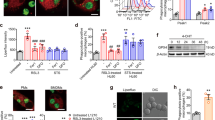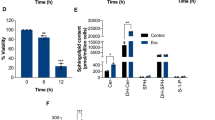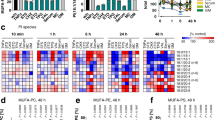Abstract
We have previously shown that activation of the acid sphingomyelinase (ASM), the release of ceramide and the formation of ceramide-enriched membrane domains are central for the induction of apoptosis by CD95. Here, we demonstrate that tumor necrosis factor-related apoptosis-inducing ligand (TRAIL) and CD95 activate the ASM via a redox mechanism resulting in release of ceramide and formation of ceramide-enriched membrane platforms. Ceramide-enriched membrane platforms serve to cluster DR5 upon stimulation. Antioxidants prevent TRAIL-mediated stimulation of ASM, the release of ceramide, the formation of ceramide-enriched membrane platforms and the induction of apoptosis by TRAIL. Further, ASM-deficient splenocytes fail to cluster DR5 in ceramide-enriched membrane domains upon TRAIL stimulation and resist TRAIL-induced apoptosis, events that were restored by addition of natural C16-ceramide. A dose–response analysis indicates that ceramide-enriched membrane platforms greatly sensitized tumor cells to TRAIL-induced apoptosis. Our data indicate that ceramide-enriched membrane platforms are required for the signaling of TRAIL-DR5 complexes under physiological conditions.
This is a preview of subscription content, access via your institution
Access options
Subscribe to this journal
Receive 50 print issues and online access
We are sorry, but there is no personal subscription option available for your country.
Buy this article
- Purchase on SpringerLink
- Instant access to full article PDF
Prices may be subject to local taxes which are calculated during checkout








Similar content being viewed by others
References
Abdel Shakor AB, Kwiatkowska K, Sobota A . (2004). J Biol Chem 279: 36778–36787.
Andrieu-Abadie N, Jaffrezou JP, Hatem S, Laurent G, Levade T, Mercadier JJ . (1999). FASEB J 13: 1501–1510.
Aouad SM, Cohen LY, Sharif-Askari E, Haddad EK, Alam A, Sekaly RP . (2004). J Immunol 172: 2316–2323.
Ashkenazi A, Pai RC, Fong S, Leung S, Lawrence DA, Marsters SA et al. (1999). J Clin Invest 104: 155–162.
Belka C, Gruber C, Jendrossek V, Wesselborg S, Budach W . (2004). Int J Radiat Oncol Biol Phys 58: 542–554.
Belka C, Marini P, Lepple-Wienhues A, Budach W, Jekle A, Los M et al. (1999). Oncogene 18: 4983–4992.
Belka C, Schmid B, Marini P, Durand E, Rudner J, Faltin H et al. (2001). Oncogene 20: 2190–2196.
Bhardwaj A, Aggarwal BB . (2003). J Clin Immunol 23: 317–332.
Bock J, Gulbins E . (2003). FEBS Lett 534: 169–174.
Boniface JJ, Rabinowitz JD, Wulfing C, Hampl J, Reich Z, Altman JD et al. (1998). Immunity 9: 459–466.
Brown DA, London E . (1998). J Membr Biol 164: 103–114.
Chan FK, Chun HJ, Zheng L, Siegel RM, Bui KL, Lenardo MJ . (2000). Science 288: 2351–2354.
Cremesti A, Paris F, Grassme H, Holler N, Tschopp J, Fuks Z et al. (2001). J Biol Chem 276: 23954–23961.
Degli-Esposti MA, Dougall WC, Smolak PJ, Waugh JY, Smith CA, Goodwin RG . (1997). Immunity 7: 813–820.
Delmas D, Rebe C, Lacour S, Filomenko R, Athias A, Gambert P et al. (2003). J Biol Chem 278: 41482–41490.
Delmas D, Rebe C, Micheau O, Athias A, Gambert P, Grazide S et al. (2004). Oncogene 23: 8979–8986.
Delpy E, Hatem SN, Andrieu N, de Vaumas C, Henaff M, Rucker-Martin C et al. (1999). Cardiovasc Res 43: 398–407.
El-Zawahry A, McKillop J, Voelkel-Johnson C . (2005). BMC Cancer 5: 2.
Emery JG, McDonnell P, Burke MB, Deen KC, Lyn S, Silverman C et al. (1998). J Biol Chem 273: 14363–14367.
Eramo A, Sargiacomo M, Ricci-Vitiani L, Todaro M, Stassi G, Messina CG et al. (2004). Eur J Immunol 34: 1930–1940.
Esen M, Schreiner B, Jendrossek V, Lang F, Fassbender K, Grassme H et al. (2001). Apoptosis 6: 431–439.
Fanzo JC, Lynch MP, Phee H, Hyer M, Cremesti A, Grassme H et al. (2003). Cancer Biol Ther 2: 392–395.
Field KA, Holowka D, Baird B . (1995). Proc Natl Acad Sci USA 92: 9201–9205.
Fulda S, Debatin KM . (2004). Biochim Biophys Acta 1705: 27–41.
Grassme H, Cremesti A, Kolesnick R, Gulbins E . (2003). Oncogene 22: 5457–5470.
Grassme H, Gulbins E, Brenner B, Ferlinz K, Sandhoff K, Harzer K et al. (1997). Cell 91: 605–615.
Grassme H, Jekle A, Riehle A, Schwarz H, Berger J, Sandhoff K et al. (2001b). J Biol Chem 276: 20589–20596.
Grassme H, Jendrossek V, Bock J, Riehle A, Gulbins E . (2002). J Immunol 168: 298–307.
Grassme H, Jendrossek V, Riehle A, von Kurthy G, Berger J, Schwarz H et al. (2003). Nat Med 9: 322–330.
Grassme H, Schwarz H, Gulbins E . (2001a). Biochem Biophys Res Commun 284: 1016–1030.
Graziadei L, Riabowol K, Bar-Sagi D . (1990). Nature 347: 396–400.
Gulbins E, Brenner B, Schlottmann K, Welsch J, Heinle H, Koppenhoefer U et al. (1996). Immunology 89: 205–212.
Gulbins E, Kolesnick R . (2000). Methods Enzymology 322: 382–388.
Hayakawa Y, Screpanti V, Yagita H, Grandien A, Ljunggren HG, Smyth MJ et al. (2004). J Immunol 172: 123–129.
Hueber AO, Bernard AM, Herincs Z, Couzinet A, He HT . (2002). EMBO Rep 3: 190–196.
Janssen EM, Droin NM, Lemmens EE, Pinkoski MJ, Bensinger SJ, Ehst BD et al. (2005). Nature 434: 88–93.
Jendrossek V, Hammersen K, Erdlenbruch B, Kugler W, Krugener R, Eibl H et al. (2002). Cancer Chemother Pharmacol 50: 71–79.
Jendrossek V, Muller I, Eibl H, Belka C . (2003). Oncogene 22: 2621–2631.
Lacour S, Hammann A, Grazide S, Lagadic-Gossmann D, Athias A, Sergent O et al. (2004). Cancer Res 64: 3593–3598.
Liu P, Ying Y, Ko YG, Anderson RG . (1996). J Biol Chem 271: 10299–10303.
Mariani SM, Matiba B, Armandola EA, Krammer PH . (1997). J Cell Biol 137: 221–229.
Morita Y, Perez GI, Paris F, Miranda SR, Ehleiter D, Haimovitz-Friedman A et al. (2000). Nat Med 6: 1109–1114.
Nurminen TA, Holopainen JM, Zhao H, Kinnunen PK . (2002). J Am Chem Soc 124: 12129–12134.
Pan G, Ni J, Wei YF, Yu G, Gentz R, Dixit VM . (1997). Science 277: 815–818.
Pan G, O'Rourke K, Chinnaiyan AM, Gentz R, Ebner R, Ni J et al. (1997). Science 276: 111–113.
Qiu H, Edmunds T, Baker-Malcolm J, Karey KP, Estes S, Schwarz C et al. (2003). J Biol Chem 278: 32744–32752.
Reinehr R, Becker S, Eberle A, Grether-Beck S, Haussinger D . (2005). J Biol Chem 280: 27179–27194.
Rohn TA, Wagenknecht B, Roth W, Naumann U, Gulbins E, Krammer PH et al. (2001). Oncogene 20: 4128–4137.
Rosenman SJ, Ganji AA, Tedder TF, Gallatin WM . (1993). J Leukoc Biol 53: 1–10.
Scheel-Toellner D, Wang K, Assi LK, Webb PR, Craddock RM, Salmon M et al. (2004a). Biochem Soc Trans 32: 679–681.
Scheel-Toellner D, Wang K, Craddock R, Webb PR, McGettrick HM, Assi LK et al. (2004b). Blood 104: 2557–2564.
Scheel-Toellner D, Wang K, Singh R, Majeed S, Raza K, Curnow SJ et al. (2002). Biochem Biophys Res Commun 297: 876–879.
Schneider P, Holler N, Bodmer JL, Hahne M, Frei K, Fontana A et al. (1998). J Exp Med 187: 1205–1213.
Sheridan JP, Marsters SA, Pitti RM, Gurney A, Skubatch M, Baldwin D et al. (1997). Science 277: 818–821.
Siegel RM, Frederiksen JK, Zacharias DA, Chan FK, Johnson M, Lynch D et al. (2000). Science 288: 2354–2357.
Simons K, Ikonen E . (1997). Nature 387: 569–572.
Um HD, Orenstein JM, Wahl SM . (1996). J Immunol 156: 3469–3477.
Ursini-Siegel J, Zhang W, Altmeyer A, Hatada EN, Do RK, Yagita H et al. (2002). J Immunol 169: 5505–5513.
Vidalain PO, Azocar O, Servet-Delprat C, Rabourdin-Combe C, Gerlier D, Manie S . (2000). EMBO J 19: 3304–3313.
Viola A, Schroeder S, Sakakibara Y, Lanzavecchia A . (1999). Science 283: 680–682.
Voelkel-Johnson C, Hannun YA, El-Zawahry A . (2005). Mol Cancer Ther 4: 1320–1327.
Walczak H, Degli-Esposti MA, Johnson RS, Smolak PJ, Waugh JY, Boiani N et al. (1997). EMBO J 16: 5386–5397.
Walczak H, Krammer PH . (2000). Exp Cell Res 256: 58–66.
Walczak H, Miller RE, Ariael K, Gliniak B, Griffith TS, Kubin M et al. (1999). Nat Med 5: 157–163.
Wiley SR, Schooley K, Smolak PJ, Din WS, Huang CP, Nicholl JK et al. (1995). Immunity 3: 673–682.
Wu GS, Burns TF, Zhan Y, Alnemri ES, El-Deiry WS . (1999). Cancer Res 59: 2770–2775.
Yamada H, Tada-Oikawa S, Uchida A, Kawanishi S . (1999). Biochem Biophys Res Commun 265: 130–133.
Yin XM . (2005). Hepatology 42: 956–958.
Acknowledgements
The studies were supported by the Association of International Cancer Research, Deutsche Krebshilfe grant 10-2238-Gu2, DFG-grant Gu 335/13-1 and the Graduiertenkolleg 1045/1 to EG.
Author information
Authors and Affiliations
Corresponding author
Rights and permissions
About this article
Cite this article
Dumitru, C., Gulbins, E. TRAIL activates acid sphingomyelinase via a redox mechanism and releases ceramide to trigger apoptosis. Oncogene 25, 5612–5625 (2006). https://doi.org/10.1038/sj.onc.1209568
Received:
Revised:
Accepted:
Published:
Issue Date:
DOI: https://doi.org/10.1038/sj.onc.1209568



